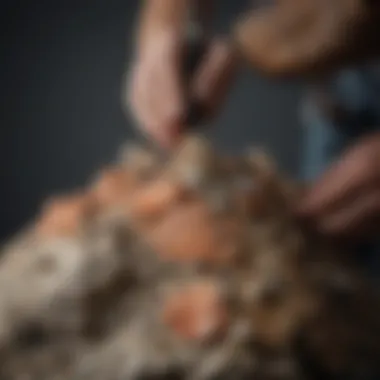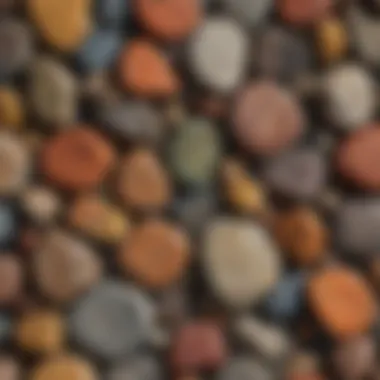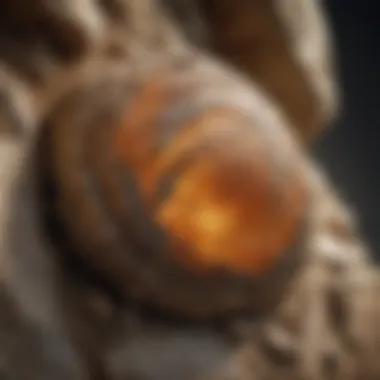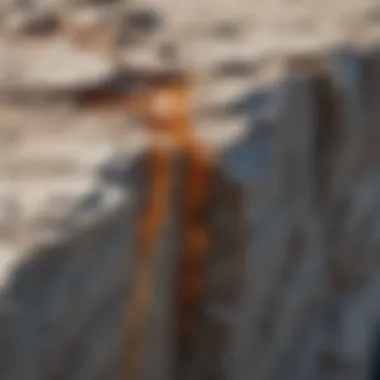Mastering the Art of Using Glue for Rocks: A Comprehensive Guide


Rock and Fossil Identification
In the realm of rock and fossil collection, identifying different types of rocks and fossils is a fundamental skill. Various types of rocks, ranging from igneous to sedimentary to metamorphic, each possess distinct characteristics that aid in identification. Fossils, on the other hand, offer glimpses into prehistoric life forms and are recognized by specific features unique to different species. Utilizing tools such as magnifying glasses, mineral hardness picks, and fossil identification guides enhances the accuracy of identification.
Collecting Tips and Techniques
For avid rock and fossil collectors, employing best practices is essential in enhancing the quality of specimens obtained. Prime collecting sites can be located through thorough research on geological maps and online resources, enabling collectors to pinpoint areas rich in geological treasures. Safely extracting specimens involves using the appropriate tools, such as rock hammers and chisels, while also being mindful of the surrounding environment to minimize impact on the ecosystem.
Preservation and Display
Preserving rocks and fossils is paramount to maintaining their integrity and longevity. Employing techniques like consolidants and adhesives helps stabilize fragile specimens and prevent decay over time. Proper storage methods, such as acid-free boxes and display cases with UV protection, safeguard specimens from environmental factors. When it comes to creative display ideas, incorporating elements like LED lighting and thematic arrangements adds a visually appealing dimension to showcasing geological wonders.
Geological Insights
Delving into geological insights provides a deeper appreciation for the world of rocks and fossils. Understanding geological formations and processes sheds light on how different rock types are created over millennia. Exploring the historical significance of rocks and fossils showcases their role in shaping our planet's natural history. Notable discoveries in the field highlight breakthroughs in paleontology and geology, unveiling fascinating insights into Earth's past.
Introduction
The world of rock and fossil collecting is as fascinating as it is delicate. In this article, we delve into the intricate art of using glue for rocks, essential knowledge that every rock and fossil collector needs to possess. From repairing cracked geodes to creating stunning rock displays, mastering the use of glue is pivotal for preserving and showcasing geological treasures with precision and finesse.
Understanding the Importance of Using Glue for Rocks
Why is Glue Essential in Rock and Fossil Collecting?
The significance of glue in the realm of rock and fossil collecting cannot be overstated. Glue serves as the invisible hand that holds together the fragments of our geological history, allowing collectors to mend broken specimens with utmost precision. Its ability to create seamless bonds between rocks of various compositions and sizes is a testament to its indispensable nature in this domain. By providing structural integrity to fragile fossils and rocks, glue ensures the longevity and completeness of the specimens, safeguarding their historical and scientific value. However, choosing the right type of glue is crucial to ensure that the repaired pieces retain their authenticity and integrity, underscoring the importance of careful selection and application.
The Role of Glue in Preserving Specimens
In the preservation of specimens, glue plays a multifaceted role that extends beyond mere adhesion. It acts as a guardian of geological stories, holding together the intricate pieces of the past with care and precision. One of the key characteristics of glue in this context is its ability to create durable and long-lasting bonds that withstand the test of time, preserving the essence of the specimens for future generations to marvel at. While its primary function is to repair and reinforce fragile rocks and fossils, glue also enhances the aesthetic appeal of the collected pieces, ensuring that they not only survive but shine in their restored glory.


Common Challenges Faced by Collectors
Despite its critical role, glue presents collectors with a set of challenges that require attention and expertise to overcome. One common challenge is selecting the appropriate glue for different types of rocks, as the wrong choice can lead to discoloration or inadequate adhesion. Additionally, mastering the art of applying glue in varying scenarios, such as repairing delicate fossils or assembling intricate rock formations, demands patience and precision to avoid irreversible damage. Moreover, ensuring that glued specimens maintain their stability over time poses another challenge, necessitating meticulous techniques and periodic inspections to detect and address any signs of deterioration promptly. By navigating these challenges with skill and knowledge, collectors can elevate their craft and uphold the integrity of their cherished collections.
Types of Glue
In the realm of rock and fossil collecting, the choice of glue plays a pivotal role in preserving, repairing, and displaying geological specimens. Understanding the different types of glue available is crucial for collectors looking to enhance their techniques and practices. Within this article, we delve into three primary types of glue commonly used in rock-related activities: Epoxy Resin, Cyanoacrylate (Super Glue), and Polyvinyl Acetate (PVA) Glue.
Choosing the Right Glue for Different Rock Types
Epoxy Resin
Epoxy resin stands out as a versatile and durable adhesive that is highly valued in the realm of rock and fossil collecting. Its key characteristic lies in its exceptional bonding strength and ability to adhere to a wide variety of materials, including different rock types such as limestone, granite, and sandstone. A notable advantage of Epoxy Resin is its resilience to environmental factors, ensuring long-term stability in display or storage. However, one must consider its longer curing time as a possible drawback, requiring patience during the application process.
Cyanoacrylate (Super Glue)
Cyanoacrylate, commonly known as Super Glue, offers quick adhesion and is favored for its instant bonding abilities. This characteristic makes it a popular choice for quick repairs or small-scale projects in the rock and fossil collecting community. Its unique feature lies in its rapid curing time, allowing for efficient work processes. While Cyanoacrylate is praised for its speed, it may not provide the same level of durability as Epoxy Resin, particularly in high-impact situations where long-term stability is crucial.
Polyvinyl Acetate (PVA) Glue
Polyvinyl Acetate, also known as PVA Glue, is a user-friendly adhesive suitable for various rock types, particularly sedimentary rocks like shale or limestone. Its key characteristic is its non-toxic nature and ease of use, making it an ideal option for collectors looking for a simple and safe bonding solution. The unique feature of PVA Glue includes its versatility in applications, ranging from repairing small fossils to creating intricate rock displays. However, its main disadvantage is its relatively weaker bonding strength compared to Epoxy Resin, requiring careful consideration based on the intended use of the glued specimens.
Techniques for Gluing Rocks
In this article, Techniques for Gluing Rocks play a pivotal role in the meticulous craft of using glue for rocks and fossils. The ability to properly glue rocks together not only ensures the preservation of specimens but also allows for the creation of stunning displays in the world of rock and fossil collecting. By mastering various techniques for gluing rocks, collectors can expertly repair broken pieces and enhance the overall presentation of their geological treasures. Understanding the intricacies of applying glue to rocks is essential for achieving long-term stability and aesthetic appeal.
Step-by-Step Guide to Properly Gluing Rocks
Surface Preparation:


Surface preparation is a critical aspect of properly gluing rocks together in this article. Before applying any adhesive, it is crucial to ensure that the surfaces to be bonded are clean, dry, and free of any debris or dust. The key characteristic of surface preparation lies in its ability to create a strong bond between the rocks, maximizing the effectiveness of the adhesive used. By meticulously cleaning and roughening the surfaces to be bonded, collectors can guarantee a secure and durable connection between the rocks. While surface preparation may require additional time and effort, its advantages in promoting adhesion and stability cannot be understated.
Application of Glue:
The application of glue is a fundamental step in the process of properly bonding rocks. This article emphasizes the importance of choosing the right type of adhesive based on the specific characteristics of the rocks being glued together. Whether using epoxy resin, cyanoacrylate (super glue), or polyvinyl acetate (PVA) glue, applying the adhesive evenly and sparingly is key to achieving a seamless bond between the rocks. The primary goal of the application of glue is to ensure that the adhesive fills any gaps or cracks between the rocks while creating a strong and durable connection. Careful consideration of the adhesive properties and the rocks' surfaces is essential for a successful bonding process in this article.
Drying and Curing Process:
The drying and curing process is the final crucial stage in properly gluing rocks together. Once the adhesive has been applied, allowing sufficient time for it to dry and cure is essential for the bond to reach its maximum strength. The key characteristic of the drying and curing process is its role in solidifying the glue and establishing a permanent connection between the rocks. Depending on the type of adhesive used, collectors must follow specific instructions regarding curing times and environmental conditions to ensure optimal bonding outcomes. While the drying and curing process may require patience, it is a vital component that guarantees the long-term stability and durability of glued specimens in this article.
Best Practices
When it comes to the realm of using glue for rocks, understanding and implementing best practices is paramount for rock and fossil collectors who seek to maintain the integrity and beauty of their specimens. This section delves into the core elements that constitute best practices, shedding light on the crucial aspects that collectors need to consider. By adhering to these practices, enthusiasts can ensure the long-term preservation of their prized rocks and fossils.
In the context of this article, best practices encompass a range of essential guidelines and methodologies that encompass everything from selecting the right type of glue for specific rock types to utilizing proper techniques for applying glue effectively. By following these best practices, collectors can avoid common pitfalls and enhance the stability and longevity of their repaired specimens. Furthermore, by incorporating these practices into their routine, collectors can elevate their display techniques, ensuring that their glued specimens are showcased in a visually appealing and secure manner. Emphasizing the importance of best practices sets the foundation for collectors to master the art of using glue for rocks effectively, empowering them to showcase their geological treasures with confidence and precision.
Tips for Effective Rock and Fossil Repair
Avoiding Common Mistakes
In the realm of rock and fossil repair, steering clear of common mistakes is key to achieving successful outcomes. One of the pivotal aspects of effective repair is the proactive avoidance of errors that can compromise the structural integrity and overall appearance of the specimens. By understanding the common missteps that collectors often encounter and learning how to circumvent them, enthusiasts can enhance their repair skills and preserve the authenticity of their rocks and fossils. Additionally, by focusing on meticulous attention to detail and precision in the repair process, collectors can mitigate the risk of rework and ensure that their specimens retain their natural appeal.
Ensuring Long-Term Stability
Ensuring the long-term stability of glued specimens is a critical consideration for rock and fossil collectors aiming to safeguard their treasures for generations to come. By prioritizing stability in the repair process, collectors can prevent premature deterioration and maintain the aesthetic value of their specimens over time. Factors such as proper application of glue, comprehensive curing processes, and strategic placement of repaired specimens contribute to the overall stability of the final display. By emphasizing long-term stability, collectors can rest assured that their repaired rocks and fossils will withstand the test of time, allowing them to be appreciated and admired by future generations.
Displaying Glued Specimens
Displaying glued specimens effectively is an art form in itself, requiring collectors to strike a balance between showcasing the beauty of the specimens and ensuring their structural integrity. Properly displaying glued rocks and fossils not only enhances the visual appeal of the specimens but also highlights the craftsmanship and dedication invested in their repair. By exploring innovative ways to present glued specimens, collectors can create captivating displays that capture the essence of each rock or fossil. Additionally, by adopting creative display techniques and considering factors such as lighting, positioning, and support structures, collectors can elevate the presentation of their specimens to new heights, captivating viewers and fostering a deeper appreciation for the geological wonders they represent.


Case Studies
In the realm of rock and fossil collection, case studies play a pivotal role in providing practical insights and real-life applications of glue usage. By delving into specific instances where glue is utilized, collectors can grasp the nuances of techniques and best practices. Case studies offer a hands-on approach to understanding the intricate art of using glue for rocks, allowing enthusiasts to learn from actual scenarios and problem-solving methods. They serve as tangible examples of how glue application can enhance preservation efforts and showcase geological specimens effectively.
Real-Life Examples of Gluing Rocks in Practice
Repairing a Cracked Geode
Repairing a cracked geode holds significant importance in rock conservation as it allows collectors to salvage valuable specimens that may have suffered damage. This aspect of the process focuses on carefully mending fractures and ensuring the structural integrity of the geode. Repairing a cracked geode is crucial in maintaining the specimen's aesthetic appeal and scientific value, making it a popular choice for collectors seeking to restore damaged rocks. The unique feature of this task lies in the meticulous application of glue to seamlessly bond the fractured parts while considering the color and transparency of the geode for a seamless finish. It presents advantages in terms of restoring the geode's beauty and structural stability while requiring attention to detail and precision in execution.
Assembling a Fossil Puzzle
Assembling a fossil puzzle contributes significantly to the overall goal of preserving and displaying fossils accurately. This process involves fitting fragmented fossil pieces together using glue to recreate the original specimen. The key characteristic of assembling a fossil puzzle lies in engaging with the evolutionary history captured within the fossil fragments. It is a beneficial choice for this article as it showcases the patience and skill required to piece together ancient remnants for educational and aesthetic purposes. The unique feature of this task is the careful alignment of fossil elements, ensuring a cohesive representation of the prehistoric creature or plant. While advantageous in reconstructing fossil puzzles for exhibition or study, it may present challenges in aligning intricate parts accurately and securely.
Creating a Rock Jewelry Piece
Crafting a rock jewelry piece adds a creative dimension to using glue for rocks, offering collectors a unique way to incorporate geological elements into wearable art. This aspect contributes to the goal of inspiring innovative display techniques and expanding the functionality of collected rocks. The key characteristic of creating a rock jewelry piece is the fusion of artistic design with geological materials, resulting in distinct and personalized accessories. It is a popular choice in this article for showcasing the versatility of glue application beyond traditional repair methods. The unique feature of this task lies in balancing aesthetic appeal with structural integrity, ensuring that the jewelry piece remains durable and visually striking. While advantageous in transforming rocks into wearable art pieces, creating rock jewelry may pose challenges in handling delicate or irregularly shaped specimens for jewelry production.
Conclusion
Gluing rocks is a meticulous art form that holds significant importance in the realm of rock and fossil collecting. Throughout this comprehensive guide, we have explored the various facets of using glue for rocks, from understanding its necessity to mastering the techniques for effective application. By delving into the intricacies of choosing the right glue for different rock types and providing insights into best practices, this article aims to equip rock enthusiasts with the knowledge needed to preserve and showcase their geological treasures with precision and care. As collectors immerse themselves in the world of using glue for rocks, they enhance their ability to repair broken specimens and elevate their creative displays, ultimately contributing to the preservation of Earth's natural wonders.
Mastering the Art of Using Glue for Rocks
Empowering Rock Collectors
Empowering rock collectors through the art of gluing rocks involves instilling a sense of confidence and skill in handling delicate specimens. The unique feature of empowering collectors lies in enabling them to take control of preserving their geological finds with precision and expertise. By mastering the techniques of using glue, collectors can independently repair and enhance the longevity of their specimens, leading to a more fulfilling and enriching collecting experience.
Enhancing Preservation Efforts
Enhancing preservation efforts goes hand in hand with mastering the art of using glue for rocks. This aspect emphasizes the critical role that proper glue application plays in ensuring the longevity and structural integrity of rock and fossil specimens. By paying attention to detail and adopting best practices, collectors elevate their preservation efforts, safeguarding their treasures for future generations to appreciate.
Inspiring Creative Display Techniques
Creativity knows no bounds when it comes to using glue for rocks. Inspiring collectors to explore innovative display techniques not only showcases their specimens in unique ways but also adds an artistic touch to their collections. The key characteristic of inspiring creative display techniques lies in encouraging collectors to think outside the box and experiment with different methods of presenting their rocks and fossils. By incorporating creativity into their displays, collectors can elevate the visual appeal of their collections and inspire others in the rock and fossil community.







